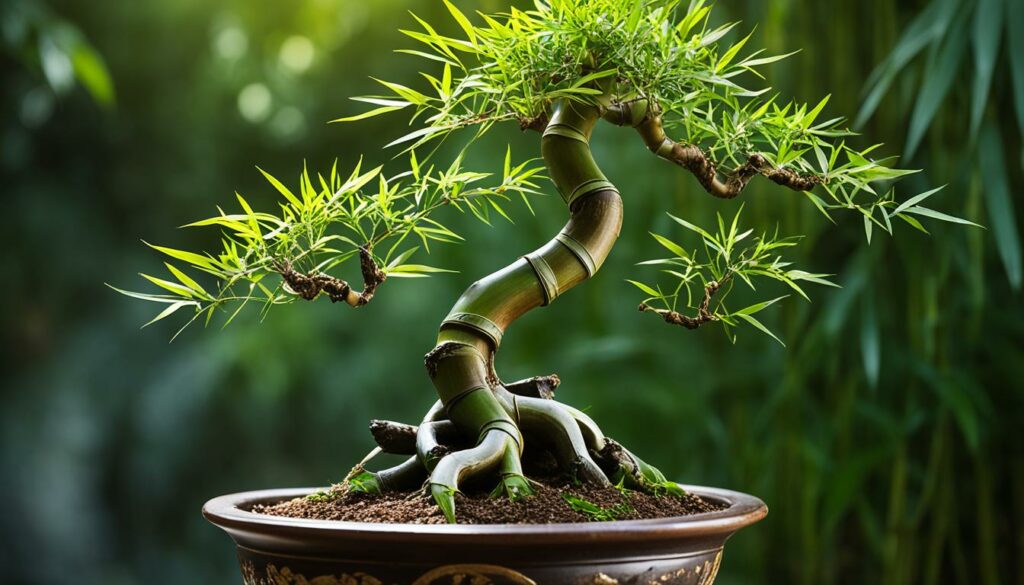Are you looking for an elegant and low-maintenance addition to your indoor garden? Look no further than the captivating world of bamboo bonsai trees! These trees are a specialized form of bonsai that offer unique characteristics and care tips, perfect for indoor enthusiasts seeking tranquility.
Bamboo bonsai trees are highly sought-after for their distinctive tall, slender culms and intricately patterned leaves. They are also renowned for their easy-care nature, making them an excellent choice for beginners and seasoned bonsai enthusiasts alike.
Key Takeaways:
- Bamboo bonsai trees are a type of specialized bonsai species.
- They are highly sought-after for their unique characteristics, including their tall, slender culms and intricately patterned leaves.
- These indoor bonsai trees are easy to care for, making them a great choice for any level of bonsai enthusiast.
- Choosing the right bamboo variety is crucial for the health and aesthetics of your bonsai tree.
- Proper potting, pruning, watering, and fertilizing techniques are essential for maintaining your bamboo bonsai’s well-being.
What is Bamboo Bonsai?
Bamboo bonsai is a unique form of bonsai that involves pruning and shaping bamboo plants to create elegant miniature versions. This indoor bonsai species is perfect for those seeking tranquility, making it a popular choice among bonsai enthusiasts.
Bamboo bonsai is known for its graceful aesthetics and delicate, intricately patterned leaves. It brings a calming presence to any indoor space, making it popular for homes and office environments alike. The size and manageable nature of bamboo bonsai also make it an ideal choice for those new to bonsai care.
While the plant itself is not a separate species of bamboo, the term “bamboo bonsai” is used to describe the art of forming bonsai trees out of bamboo plants. The process involves growing bamboo in small containers and shaping the plant’s stem and foliage over time. The goal is to create a miniature version of a full-grown bamboo plant that retains all the grace and elegance of the original.
Characteristics of Bamboo Bonsai
Bamboo bonsai trees have unique qualities that make them a popular choice for indoor bonsai enthusiasts. Their tall, slender culms (stems) and intricately patterned leaves create an exquisite appearance that can enhance any room. What’s more, bamboo bonsai is a species that is easy to care for, making it an ideal choice for both novice and seasoned bonsai keepers.
One of the most distinct features of bamboo bonsai is their thin, vertical culms that can rise to several feet in height, depending on the species. These culms can grow leaves that are variegated and elegant, each with its unique shape and size. As a result, bamboo bonsai trees can be shaped and trimmed to create a variety of styles and designs.
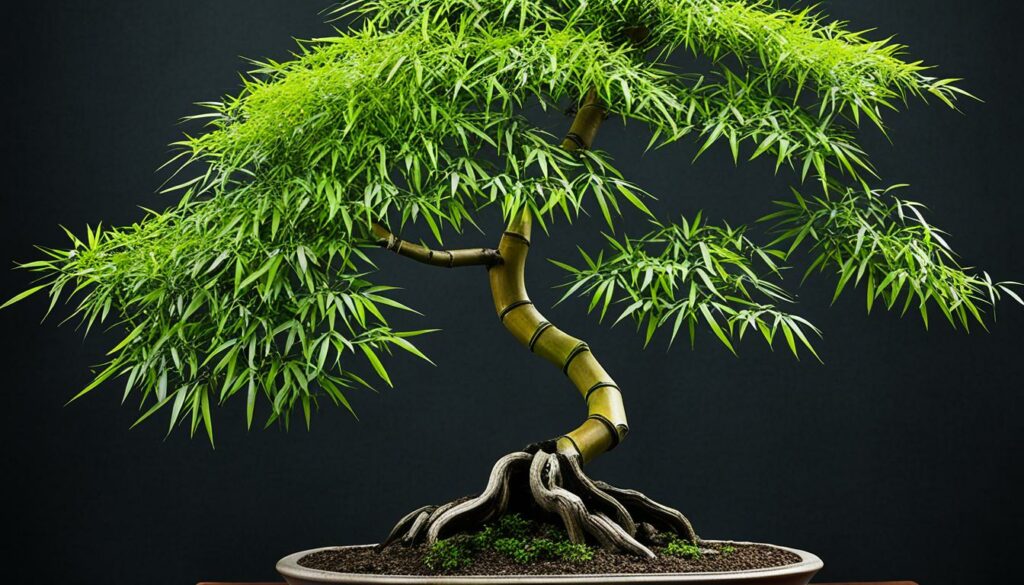
Another advantage of bamboo bonsai is that, compared to other indoor bonsai species, they are relatively easy to care for. They are hardy and can adapt to varying conditions, so you won’t have to worry much about them as long as you water and fertilize them properly. Most bamboo bonsai thrive in areas with bright, indirect light and moderately humid conditions, making them perfect for indoor areas of your home.
To maintain the health and aesthetics of your bamboo bonsai and ensure its longevity, you need to provide it with the appropriate potting and pruning. Choosing the right container matters as well, as they need sufficient drainage and support. Regular watering and fertilizing, as well as light and temperature control, are also vital for your bamboo bonsai’s optimal growth. Diseases and pests are a threat to any plant’s survival, posing a particular hazard to indoor plants such as bamboo bonsai. Watch out for signs of infestation or disease to control these issues immediately.
Next, let’s take a look at how to select the right bamboo variety for your bonsai.
Selecting the Right Bamboo Variety
When choosing a bamboo variety for your bamboo bonsai, it is important to keep in mind its growth habit, size, and compatibility with indoor environments.
A popular choice for bonsai enthusiasts is the Phyllostachys aurea, also known as the Golden Bamboo. This bamboo species is known for its vibrant foliage and hardy nature. Another popular option is the Phyllostachys nigra, or Black Bamboo, which boasts striking black culms and lush foliage.
If you’re looking for a dwarf variety, the Bambusa ventricosa, also known as Buddha Belly or Ventricose Bamboo, is a compact option that is easy to care for and maintain in small spaces.
| Bamboo Variety | Growth Habit | Size | Indoor Compatibility |
|---|---|---|---|
| Phyllostachys aurea | Upright | Up to 20 ft | Excellent |
| Phyllostachys nigra | Upright | Up to 30 ft | Excellent |
| Bambusa ventricosa | Compact | Up to 8 ft | Excellent |
Whichever bamboo variety you choose, ensure that it suits your unique preferences and the indoor environment where it will be kept. By selecting the right variety, you’re taking the first step towards cultivating a stunning and thriving bamboo bonsai tree that will bring tranquility and joy to your indoor space.
Potting and Pruning Bamboo Bonsai
Proper potting and pruning are crucial for maintaining the health and aesthetics of your indoor bamboo bonsai. When selecting a container for your bamboo bonsai tree, opt for one that has sufficient drainage holes to prevent water from accumulating and causing root rot. You can use a pre-mixed bonsai soil, or create your own mix of inorganic and organic materials to ensure proper drainage and aeration.
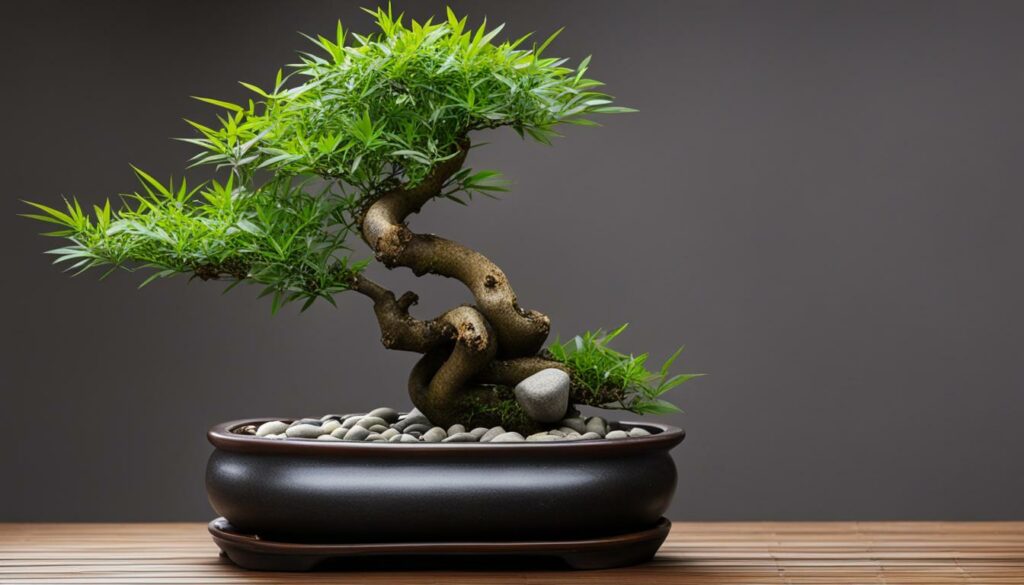
The best time to prune your bamboo bonsai is in early spring, just before new growth appears. Use sharp, sterilized pruning shears to make clean cuts, and take care not to damage the surrounding foliage or culms (stems). Keep in mind that bamboo bonsai trees grow quickly, so regular pruning will help maintain the desired shape and prevent overcrowding.
Watering and Fertilizing Bamboo Bonsai
Proper watering and fertilizing are crucial to the overall health and well-being of your bamboo bonsai. However, it’s essential to take a balanced approach to ensure you don’t over or underdo it.
When watering your indoor bonsai, ensure the soil remains moist, but not overly wet. Overwatering can lead to root rot and other fungal diseases. On the other hand, underwatering can cause the soil to dry out, leading to stunted growth and wilting foliage.
To determine whether your bamboo bonsai needs watering, insert your finger into the soil up to the first knuckle. If the soil feels dry, it’s time to water. Otherwise, wait another day or two and check again.
Note: It’s always a good idea to use a well-draining soil mix when potting your bamboo bonsai to promote healthy root growth and prevent waterlogging.
As for fertilizing your indoor bonsai, it’s best to use a slow-release fertilizer during the growing season. Typically, you should fertilize your bamboo bonsai once every four to six weeks. However, follow the instructions provided with your specific fertilizer to ensure you don’t overdo it.
Note: Avoid fertilizing your bonsai during the winter or dormancy period, as this can burn the roots and cause severe damage.
By following the proper watering and fertilizing practices, you can ensure your bamboo bonsai thrives and retains its elegant beauty for years to come.
Light and Temperature Requirements
As with all indoor bonsai trees, providing the right amount of light and temperature is crucial to ensure your bamboo bonsai thrives.
Bamboo bonsai trees prefer bright, indirect light, so place them near a sunny window or under a grow light for 12-14 hours a day. However, avoid exposing them to direct sunlight, which can scorch the delicate leaves.
Indoor temperatures between 60-75°F (15-24°C) are ideal for bamboo bonsai. Keep your tree away from drafty areas or extreme temperatures, as sudden fluctuations can cause stress and damage to your bonsai.
Remember that consistent care and attention will help your bamboo bonsai tree thrive. When in doubt, always consult a trusted bonsai expert or reference guide for more personalized care instructions.
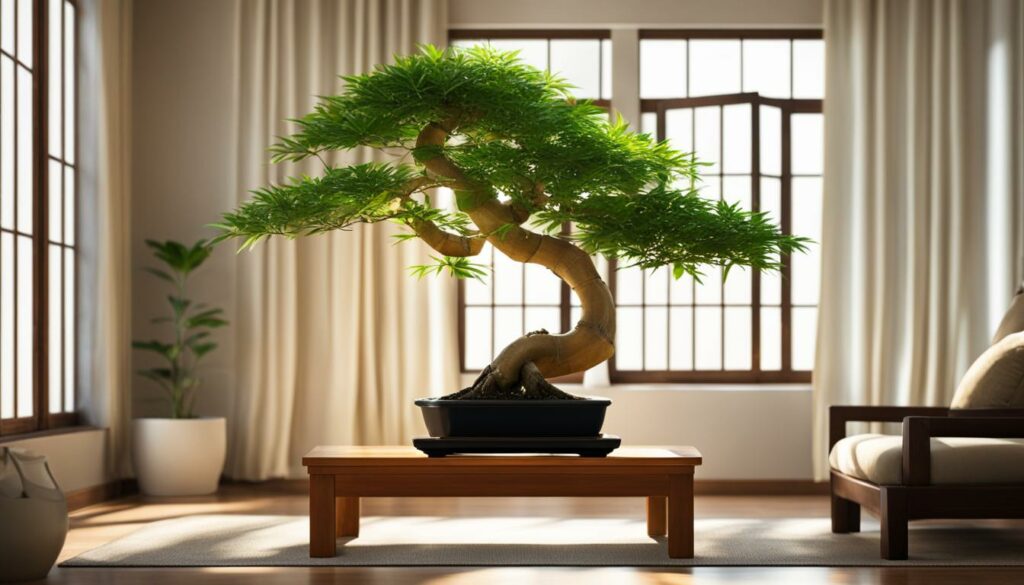
Common Pests and Diseases
Despite their reputation for resilience, bamboo bonsai trees are still vulnerable to various pests and diseases. Early detection and prevention are crucial to keep your indoor bonsai healthy and thriving.
Pests
The most common pests affecting bamboo bonsai are spider mites and scale insects. Spider mites are tiny, spider-like pests that can cause yellowing leaves and a fine webbing on the plant’s surface. Scale insects are small, flat insects that attach themselves to the plant and can cause yellowing leaves, stunted growth, and premature leaf drop.
To prevent and treat infestations, regularly inspect your bamboo bonsai for signs of pests. Isolate any infected plants immediately to avoid spread, and treat with an appropriate insecticide or miticide according to the product’s label instructions.
Diseases
One of the most common diseases that affect bamboo bonsai is root rot. Root rot occurs when the roots are exposed to standing water or soil that doesn’t drain effectively, leading to fungal growth and decay.
To prevent root rot, ensure proper drainage by selecting well-draining soil and a container with adequate drainage holes. Avoid overwatering your bamboo bonsai and never let it sit in standing water for prolonged periods. If you notice signs of root rot, such as wilting leaves or soft, discolored roots, immediately cut away the affected areas and repot in fresh soil.
Tip: Regularly cleaning your bamboo bonsai (leaves, stems, and container) can help deter pests and fungi, promoting your indoor bonsai’s overall health.
Regular maintenance and care practices can help prevent common pests and diseases from affecting your bamboo bonsai. By familiarizing yourself with these potential problems and taking prompt action, you can enjoy a thriving and elegant indoor bonsai for years to come.
Displaying and Styling Bamboo Bonsai
Once you’ve learned to care for your bamboo bonsai, it’s time to showcase its graceful beauty through creative display and styling techniques. With its slender stems and delicate leaves, bamboo bonsai looks stunning in a variety of settings, from traditional Japanese-inspired gardens to modern minimalist interiors. Here are a few ideas to get you started:
Bamboo Bonsai in Zen Gardens
The calming presence of bamboo bonsai makes it an ideal addition to a Zen garden. Use sand or gravel to create a minimalist landscape, and position your bamboo bonsai carefully for maximum impact. You can also add rocks, water features, and other elements to create a serene and meditative atmosphere.
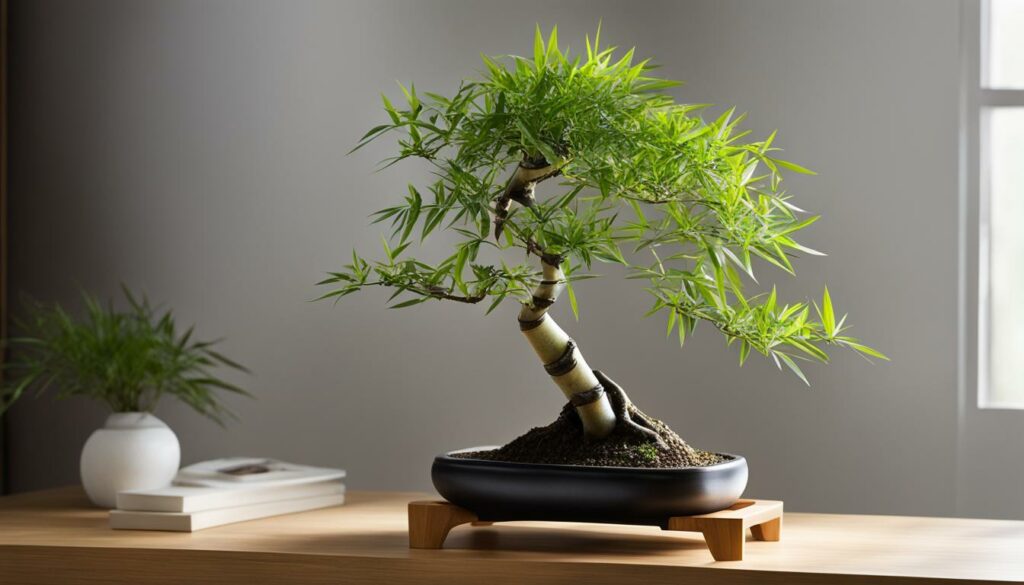
Bamboo Bonsai in Modern Interiors
For a contemporary twist, display your bamboo bonsai in a sleek, minimalist container that complements your interior design scheme. Think neutral tones, clean lines, and geometric shapes. Position your bamboo bonsai near a window to take advantage of natural light, or use artificial lighting to create a dramatic effect.
Bamboo Bonsai as a Centerpiece
No matter what your decorating style, bamboo bonsai makes a beautiful and unique centerpiece for your dining or coffee table. Choose a shallow container that allows the intricate root system of your bamboo bonsai to add visual interest. You can also add moss, rocks, or other natural elements to create a mini landscape within the container.
Bamboo Bonsai in Groupings
If you have several bamboo bonsai trees, consider grouping them together for a striking display. Use different container shapes and sizes to add visual interest, and position the trees at varying heights to create depth and dimension. You can also add other indoor bonsai species, such as juniper or ficus, for a diverse and compelling grouping.
Famous Bamboo Bonsai Examples
Embark on a journey through the enchanting world of bamboo bonsai trees, and witness the creative artistry of renowned bonsai masters. These famous examples showcase the unique beauty and versatility of indoor bamboo bonsai species, inspiring awe and delight in all who behold them.
The Shibui Bonsai Gallery’s Phyllostachys aureosulcata Bamboo Bonsai
One of the most impressive bamboo bonsai creations is the spectacular Phyllostachys aureosulcata specimen grown by Jerry Meislik, a leading bonsai artist and author. This bamboo bonsai is called the Shibui Bonsai Gallery’s showcase masterpiece, boasting a height of 36 inches and a trunk diameter of 8 inches. The elegant, fully-formed crown of the bonsai features graceful culms that sway gently in the breeze, while the intricate roots curl around the pot in an exquisite dance.
The National Bonsai Foundation’s Phyllostachys nigra Bamboo Bonsai
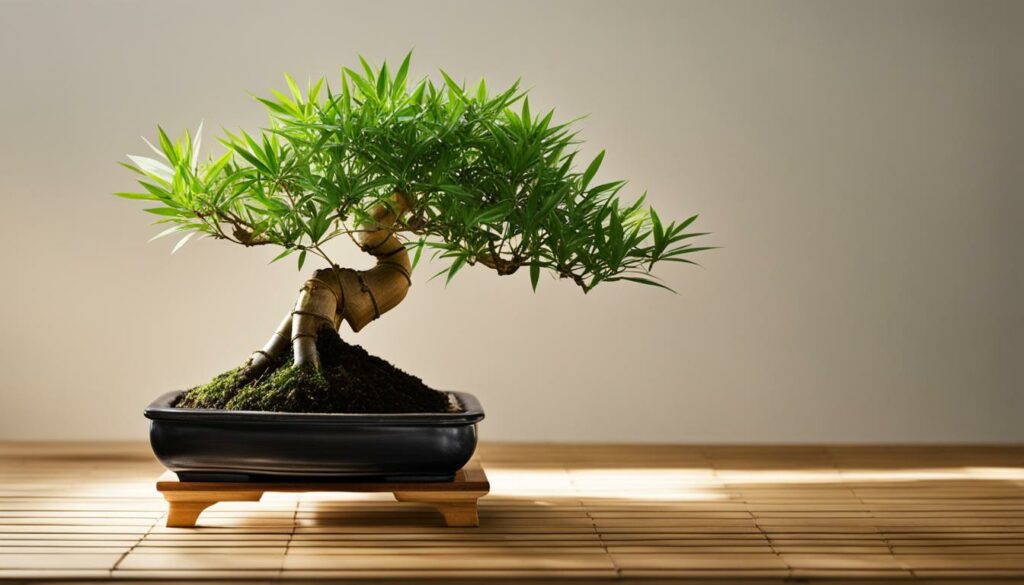 The National Bonsai Foundation houses a rare and awe-inspiring Phyllostachys nigra bamboo bonsai, which is considered to be one of the oldest and most valuable in the world. Discovered in China and imported to the US, this stunning bonsai stands at a height of 67 inches, with a trunk diameter of 5 inches. The simple yet elegant design showcases the inherent beauty of the bamboo, with slender culms and rich, verdant foliage.
The National Bonsai Foundation houses a rare and awe-inspiring Phyllostachys nigra bamboo bonsai, which is considered to be one of the oldest and most valuable in the world. Discovered in China and imported to the US, this stunning bonsai stands at a height of 67 inches, with a trunk diameter of 5 inches. The simple yet elegant design showcases the inherent beauty of the bamboo, with slender culms and rich, verdant foliage.
The Arizona Bonsai Society’s Bambusa ventricosa Bamboo Bonsai
Another remarkable bamboo bonsai creation is the Arizona Bonsai Society’s Bambusa ventricosa, lovingly tended by John Kirby. This stunning bonsai stands at a height of 39 inches, with a trunk diameter of 3 inches. The intricate shaping and detailed root structure highlight the beauty of the bamboo species, with delicate leaves that shimmer in the light.
Each of these famous bamboo bonsai examples showcases the awe-inspiring beauty and creativity of expert bonsai masters. Discover the timeless artistry and natural grace of indoor bamboo bonsai trees, and appreciate the meticulous care and patience required to cultivate these stunning living works of art.
Conclusion
Congratulations on taking the time to learn about the captivating world of bamboo bonsai. Whether you’re a seasoned bonsai enthusiast or a beginner, bamboo bonsai is an excellent choice for your indoor space. With its unique characteristics, ease of care, and aesthetic appeal, bamboo bonsai brings tranquility and grace to any environment.
Remember to select the right variety and container, practice proper potting and pruning techniques, and maintain optimal moisture and nutrient levels. Protect your bamboo bonsai from extreme temperatures and common pests and diseases, and explore creative display and styling techniques to showcase its beauty.
Thank you for reading our comprehensive guide to bamboo bonsai care. We hope you found it informative and helpful in your bonsai journey. Enjoy the serenity and elegance that bamboo bonsai can bring into your life!
FAQ
What is bamboo bonsai?
Bamboo bonsai is a specialized form of bonsai where bamboo plants are pruned, shaped, and cultivated in small containers. It is a unique and elegant bonsai species that brings a calming presence to any indoor space.
What are the characteristics of bamboo bonsai?
Bamboo bonsai trees are known for their tall, slender culms (stems) and delicate, intricately patterned leaves. They are easy to care for, making them perfect for both beginners and experienced bonsai enthusiasts.
How do I select the right bamboo variety for bonsai?
When choosing a bamboo variety for bonsai, consider its growth habit, size, and compatibility with indoor environments. Popular bamboo species for bonsai include Phyllostachys aurea, Phyllostachys nigra, and Bambusa ventricosa.
What are the potting and pruning techniques for bamboo bonsai?
Proper potting and pruning are essential for maintaining the health and aesthetics of bamboo bonsai. Learn how to select suitable containers, provide adequate drainage, and shape your bonsai tree to achieve its desired form.
How should I water and fertilize bamboo bonsai?
Understanding the correct watering and fertilizing practices for bamboo bonsai is crucial for its overall well-being. Find out how to strike a balance between moisture levels and nutrient availability to ensure your bonsai thrives.
What are the light and temperature requirements for bamboo bonsai?
Bamboo bonsai thrives in bright, indirect light. However, care should be taken to protect it from extreme temperatures and sudden fluctuations.
What pests and diseases should I be aware of for bamboo bonsai?
Although resilient, bamboo bonsai trees can still be susceptible to pests such as spider mites and scale insects. Learn how to prevent and treat common issues effectively.
How can I display and style my bamboo bonsai?
Explore different ways to showcase your bamboo bonsai’s beauty through creative display and styling techniques. From serene Zen gardens to minimalist living spaces, bamboo bonsai adds an elegant touch to any environment.
Are there any famous examples of bamboo bonsai?
Immerse yourself in the world of renowned bamboo bonsai masterpieces. Discover notable examples that highlight the versatility and artistry of this bonsai species.
